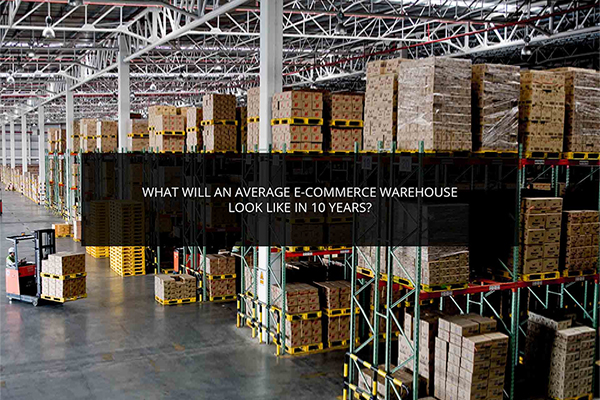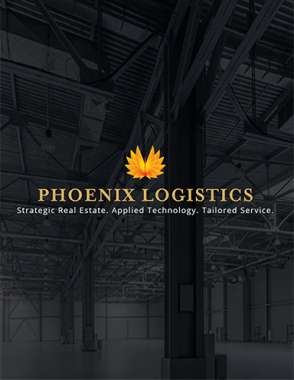What Will an Average E-Commerce Warehouse Like in 10 Years?

What will e-commerce warehouses look like in 10 years? Though predicting the future certainly has a margin of error, we can make educated forecasts about the future of warehousing.
Warehousing Operations
The warehousing sector has long relied upon manual labor as the driving force behind operations.
Though numerous efficiency-improving technologies have become commonplace in warehouses over the years, the growing logistics labor shortage has accelerated technology adoption in the sector, both in the United States and globally.
Threats of supply chain disruption have also shaken up best practices in the modern warehouse. Because of these trends, industry stakeholders have become accustomed to change and innovation as part of a new normal.
With this in mind, you might wonder: What will e-commerce warehouses look like in 10 years? Though predicting the future certainly has a margin of error, we can make educated forecasts about the future of warehousing. So, read on to see how today’s trends will influence warehouses in the 2030s.
Turning Out The Lights
The manufacturing sector gained “Lights Out Manufacturing” capabilities more than 20 years ago. This term refers to fully automated factories that don’t require human intervention during production runs. The human staff in such facilities typically consists of maintenance workers, engineers, and quality assurance personnel.
However, manufacturers can only achieve this capability because mass-producing parts and goods is a highly repeatable process that automated machine tools can easily learn.
Conversely, the logistics sector can’t yet fully automate an e-commerce warehouse because of the number of variables involved in fulfillment. Warehouse drones already exist that offer non-stop scanning of packages with near 100% accuracy.
Some fulfillment centers use collaborative robots - known as cobots - to pick items and bring them to warehouse associates for packing, perform repetitive tasks known to cause strains and injuries in human workers, and more. Lights Out Warehousing is on the cusp of becoming a reality as these technologies continue advancing.
Sustainability As a Standard
A rise in global surface temperatures has resulted in an increase in powerful tropical storms and droughts that create favorable conditions for wildfires. The growing impact of these events on supply chains has caused many companies to double down on their environmental, societal, and governance (ESG) initiatives. As part of this trend, the popularity of green warehouses is on the rise.
Ten years from now, the following features will be common in e-commerce fulfillment centers, reflecting companies’ efforts to decarbonize operations:
- Energy-efficient lighting
- Electric forklifts to avoid burning fossil fuels
- Solar panels to reduce strain on the public grid
- Green roofing systems to mitigate heat and lower pollution
- Modular construction to reduce material waste
Non-Traditional Warehouses
When it comes to warehouse sizes, e-commerce sellers have been consistently pushing the boundaries on size in both directions to locate inventory closer to customers. For example, Amazon has a 3.2 million square foot distribution center in Tennessee - one of the largest industrial buildings in the United States.
On the opposite side, micro-fulfillment centers have popped up to serve the e-commerce needs of the U.S. grocery and retail sectors, with some as small as 5,000 square feet - roughly the size of a standard basketball court. In addition, multi-story warehouses are gaining popularity in U.S. markets, which further shakes up traditional warehouse designs by building vertically.
Architects will continue to think outside the box regarding warehouse size and shape as they struggle to meet the demand for industrial inventory over the next several years. Moreover, this creativity will have a longer-term influence on industrial real estate as more e-commerce businesses realize that traditional warehouses aren’t the only option available.
About Phoenix Investors
Founded by Frank P. Crivello in 1994, Phoenix Investors and its affiliates (collectively “Phoenix”) are a leader in the acquisition, development, renovation, and repositioning of industrial facilities throughout the United States. Utilizing a disciplined investment approach and successful partnerships with institutional capital sources, corporations, and public stakeholders, Phoenix has developed a proven track record of generating superior risk-adjusted returns, while providing cost-efficient lease rates for its growing portfolio of national tenants. Its efforts inspire and drive the transformation and reinvigoration of the economic engines in the communities it serves. Phoenix continues to be defined by thoughtful relationships, sophisticated investment tools, cost-efficient solutions, and a reputation for success.
Article Topics
Phoenix Logistics News & Resources
4 Best Practices for Online Order Fulfillment In 2023 Is Industrial Real Estate Recession-Proof? 9 Tips for Offsetting Rising Parcel Rates Tips for Retaining Your Peak Season Temp Labor The Great Decoupling and What It Means for Industrial Real Estate How Does the Inflation Reduction Act Impact Industrial Real Estate? Not in My Backyard: Warehouse Edition More Phoenix LogisticsLatest in Warehouse|DC
Ranking the World’s 10 Biggest Supply Chains The Top 10 Risks Facing Supply Chain Professionals Walmart’s Latest Service: Ultra Late-Night Delivery Dollar Tree’s Oklahoma Distribution Center Decimated by Tornado European Parliament Passes Law on Supply Chain Accountability Transforming Warehousing with AI: Five Key Reasons to Adopt Now Talking Supply Chain: Understanding the FTC’s ban on noncompetes More Warehouse|DC













